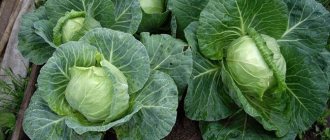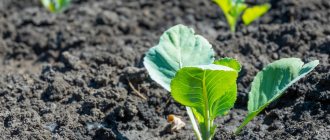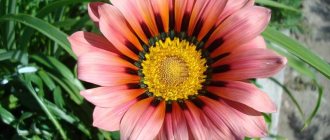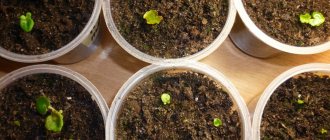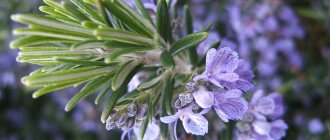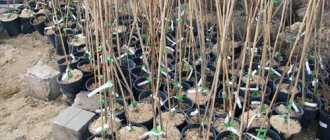How and when to plant cauliflower seedlings? How to care for cauliflower seedlings at home? How to plant cauliflower seedlings in open ground?
In our country, cauliflower has become popular relatively recently. Infants are considered the biggest admirers and consumers of this vegetable, because it is part of their first complementary foods.
Our gardeners are not very willing to take on the task of growing cauliflower, since this crop is quite finicky and capricious. Cauliflower will produce a good harvest only under certain temperature conditions - not lower than 10 degrees and not higher than 26 degrees. It is almost impossible to provide such a stable climate naturally, which is why most often cauliflower grows in greenhouses or greenhouses.
When to sow cauliflower in a greenhouse for seedlings?
When to sow cauliflower in a greenhouse for seedlings?
- If a greenhouse or greenhouse is equipped with an additional heating system, then you can sow cauliflower seedlings in them all year round.
- If there is no autonomous heating in the greenhouse, you can plant the seedlings of this crop in the last days of January on the window, and they can be transplanted into the greenhouse already in the last days of March or the first days of April.
Sowing seeds
it is advisable to take only large seeds for sowing . Before sowing, they are heated for 20 minutes in hot water at a temperature of exactly 48–50°C, then quickly cooled in cold water and soaked in a solution of potassium permanganate for 8 hours.
Seeds prepared for sowing are sown in nutrient pots or seed boxes. Usually they use boxes 50 cm long, 30 cm wide, 10 cm high with a removable front wall. Small shards or pebbles are placed at the bottom of the box to improve drainage. The soil mixture is prepared from 3 parts lowland peat and one part humus. Add 30 g of superphosphate, 15 g of potassium sulfate and 0.5 teaspoon of boric acid to a bucket of this mixture. The cubes are cut into a box or the mixture is filled into 6x6 cm bags made of film or magazine paper.
On a leveled, moistened and slightly compacted nutrient mixture, mark grooves 0.5 cm deep with a distance of 3 cm between them. The seeds are laid out in them every 1.5 cm, covered with the same mixture and lightly compacted.
What do cauliflower seedlings look like?
You can see what cauliflower seedlings look like in the photos below:
Photo of cauliflower seedlings
Cauliflower seedlings
Diseases and pests
Cauliflower is often affected by diseases:
- Mucous bacteriosis,
- Blackleg,
- Kila,
- Downy mildew,
- Vascular bacteriosis.
Pests:
- Cruciferous flea beetles,
- Cabbage flies
- Secretive proboscis
- Aphid,
- fly moth,
- Sovka et al.
Plants that receive elements for their growth and development in time become resistant to diseases and pests.
How to distinguish cauliflower seedlings from white cabbage?
White cabbage shoots
- This question is difficult even for experienced gardeners. The fact is that almost all varieties and varieties of cabbage, being in the seedling stage, are very similar to each other.
- Some experts identify cauliflower by its rounder, smaller leaves. In white cabbage they are delicate.
- No matter how professional you are, it is very difficult to distinguish sprouts of white cabbage from cauliflower by eye, so purchase seedlings only from trusted sellers.
How to water cauliflower seedlings?
Watering cauliflower seedlings
- The soil with cauliflower seedlings should never dry out, so it should be provided with timely, moderate watering.
- The best way to water cauliflower seedlings is by sprinkling.
- This plant needs to be watered with water whose temperature is slightly higher than the temperature of the soil in which it grows.
Picking cauliflower seedlings at home
Picking cauliflower seedlings
- Many gardeners do not recommend picking cauliflower at all, but immediately planting it in a separate container.
- The fact is that when this plant is transplanted, its root system experiences severe stress and may not be able to cope with such a complex rehabilitation process.
- If, nevertheless, it was decided to pick cauliflower, then this action must be performed no later than 7-10 days after the appearance of the first shoots.
- The best option for picking cauliflower is considered to be a peat pot, which can be purchased at specialized gardening outlets or made with your own hands.
- A peat pot will ensure the safety and integrity of the plant’s root system when planting it in open ground.
- You need to plant cauliflower in pots up to the cotyledon leaves.
- After replanting, it is best to mulch the plant with wood ash.
- Experienced gardeners recommend picking cauliflower in several stages - first transplanting some of the sprouts, and the next day or every other day, after analyzing the condition of the transplanted plants, picking the remaining ones.
At what temperature to grow cauliflower seedlings?
Temperature for growing cauliflower
- During the entire period before the appearance of the first shoots of cauliflower, it is advisable to organize the temperature at 20-22 degrees.
- As soon as the first sprouts emerge through the ground, they must immediately be moved to conditions with a 10-12 degree temperature.
- After a week, it is recommended to keep the sprouted seedlings at a temperature of 12-15 degrees.
Planting depending on region
Each region of Russia has its own climatic conditions, this should be taken into account when planting cauliflower, as this may cause planting dates to vary. The timing may vary not only by several days, but also by a week.
Sometimes you may need to plant a month later or earlier. Therefore, you need to take into account the climate characteristics of your region
The best areas for growing cauliflower: Moscow, Moscow region, Tula, Lipetsk, Voronezh. These areas have the most favorable climate in spring for growing this vegetable.
In these areas, it is best to grow early or mid-ripening varieties of cauliflower, since in August the nights are quite cold, this does not allow varieties that have a long ripeness to grow to maturity. Therefore, it is necessary to plant in these regions from the last days of February to mid-March.
In the Leningrad region, the climate is characterized by high humidity and lower temperatures. Therefore, cauliflower should be planted only in greenhouses and only in seedlings.
In the Urals and Siberia, you can also grow cauliflower, but only in seedlings and with further planting into the beds. But only early ripening varieties can be grown here, as they are resistant to low temperatures. These areas have fairly cold summers, so resistance to cold is a must for plants.
In the southern regions of the country, namely in such as the Krasnodar Territory, Kuban and the Crimean Peninsula, planting should be done at the very beginning of spring, or rather, when the air warms up to 7 degrees. A little coolness helps the plant adapt to the climate faster.
Some gardeners in Krasnodar plant cauliflower as winter garlic. That is, they sow cabbage in the fall, this little trick helps them harvest in the middle of spring. Also, such plants are much less susceptible to pests and diseases.
The warm climate allows gardeners to continuously grow first early-ripening, then mid-ripening, and then late-ripening varieties.
Such production allows them not only to stock up on cauliflower, but also to make preparations for the winter. In Belarus and Ukraine, the climate in the spring is similar to the climate in central Russia, so the time and timing of planting will not differ. You need to focus on the cyclone that arrives at one time or another.
Planting cauliflower seedlings in open ground
Selecting a location
Choosing a bed for cauliflower
- When choosing a place for cauliflower, you need to focus on its love for heat, sun and high humidity.
- As for the composition of the soil, loamy and sandy loam soils with a neutral pH are considered the most suitable for this plant.
- Cruciferous crops are bad predecessors for cauliflower.
- It is advisable to fertilize the land for planting this crop with manure or compost in the fall, and in early spring you can only add complex mineral fertilizers to it.
Transplanting
Planting cauliflower seedlings in open ground
- When the ground for planting cauliflower is ready, you can make holes in it for seedlings with a depth equal to the height of a peat or regular pot.
- If, after picking, the cauliflower seedlings are in peat pots, then they can be planted directly into the ground.
- If the cabbage sprouts are “sitting” in an ordinary container, then they must be carefully released and, together with a lump of earth, lowered into the hole.
- It is recommended to bury cauliflower until the first leaves.
- When cabbage is planted, it needs to be watered thoroughly.
Favorable days according to the Lunar calendar
Lunar calendars are simply an irreplaceable thing for a person who is interested in growing various crops.
Using it, you can determine on which days it is best to plant a particular crop. Cauliflower is no exception; the most favorable days for planting this wonderful vegetable are:
- in February - 5-7, 15-16, 27-28;
- in March - 4.5, 12, 13, 28-31;
- in April - 1, 5, 11, 12, 26-30;
- in May - 6, 7, 10, 12, 26-31;
- in June - 2-4, 8, 10, 26-30;
- in July - 2-4, 9.10, 24-27.
If it so happens that you do not have the opportunity to land on a favorable day, then you can do this on any other day.
But you need to remember that there are days on which you absolutely cannot plant cauliflower. When planning planting, focus on the prohibited days:
- in February – 8, 9, 21, 22;
- in March – 7, 8, 19, 20, 21, 24;
- in April – 3, 4, 15, 17, 20, 22;
- in May – 1, 13, 14, 18, 19, 29;
- in June – 9, 11, 14, 16, 24, 25;
- in July – 7, 8, 11, 13, 21, 22.
At what distance should I plant cabbage seedlings?
Required distance between cauliflower seedlings
- Early varieties of cauliflower should be planted at a distance of 25cm from each other and 70cm between rows.
- Late varieties of seedlings are planted at a distance of 35 cm from each other and 80 cm between rows.
We hope that thanks to our tips, you will be able to grow gorgeous cauliflower seedlings.
When to plant?
This question worries most beginning gardeners, and for good reason, because there are plenty of dates for planting:
- Favorable conditions for planting seedlings are observed from March 15 to March 23. Early ripening varieties, as well as hybrids, are recommended for planting, followed by replanting after 35 days.
- The second date falls at the end of March. This period is most favorable for propagating seedlings of mid-late species, followed by transplanting into the ground after 40 days.
- The next window falls from April 25 to May 13. This period is favorable for planting mid-late varieties, with transplantation after 35 days.
- And the last chance for planting is from June 5 to June 17. During this period, late varieties are planted, followed by transplantation into the ground after 33-34 days.
